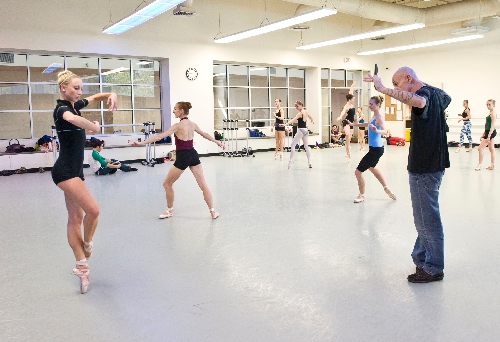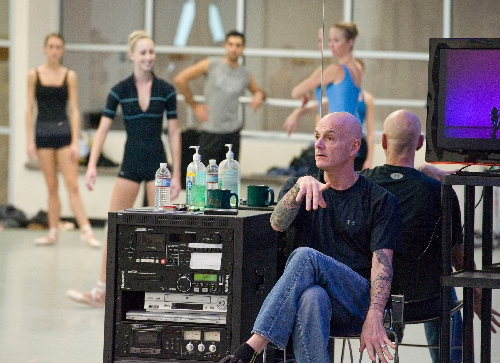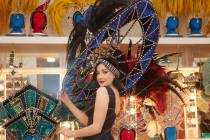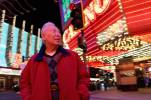Nevada Ballet Theatre opens 40th season pairing with Chicago dance troupe at Paris Las Vegas
Orgasm, 3-D, Blue Moon, you saw me standing alone ...
Which of course means that you're having sex in three dimensions while singing a 1934 ballad -- or you've been scarfing those funny brownies again.
Or you're watching ballet.
"This is a program that will have great contemporary dance," says James Canfield, artistic director of Nevada Ballet Theatre, which opens its 40th season this weekend with a program titled "Dance Dance Dance!" at Paris Las Vegas.
"This is neoclassicism into some of today's most contemporary works."
Getting a creative boost from the Second City, Nevada Ballet shares the bill with Hubbard Street Dance Chicago. Directed by Glenn Edgerton and nipping at Nevada Ballet's longevity with 34 years of its own, Hubbard has been praised for what critics call its "exuberant and athletic" style.
As for the program ...
Orgasm? That's "Petite Mort." 3-D? That's "Too Beaucoup." "Blue Moon"? That's "Up." Well, that's not all they are. Explanations pending.
Eclecticism is the watchword.
Performed by Nevada Ballet, "Concerto Barocco," by dance icon George Balanchine, premiered in 1941, with dancers representing violins that personify the accompanying music of Johann Sebastian Bach, the piece punctuated by swift jumps and clean arm movements.
Notably, with "Barocco," Balanchine was lauded for breaking from plot and character to concentrate on the movements of the human body. "Concerto Barocco" was on the program of the then-new New York City Ballet in 1948 and has been in its repertoire ever since.
"He wanted people to understand how movement and music relate to one another," Canfield says. " 'Concerto Barocco' epitomizes that."
Ceding the stage to their Chi-town guests brings "Too Beaucoup," created this year for Hubbard by Sharon Eyal and Gai Behar, with music by Ori Lichtik. Mimicking robotic movements, the piece evokes the sense of watching a 3-D movie in an alien world, filled with albino creatures. "It's more androgynous, they're extraterrestrial beings, on a planet of their own wearing white wigs and white contacts," Canfield says.
"The choreographer was making a statement as to how technology has moved us so far and fast and away from each other and we think we're communicating but we're not. Our heads are down; our lives are in our cellphones."
Taking back the stage, Nevada Ballet looks to its own source of inspiration, performing Canfield's "Cinq Gnossiennes." Five dancers execute fluid choreography, exploring human relationships with live musical accompaniment.
"What inspired it was my meditating on death and loss," Canfield says. "What would you have said if you had one more time to talk? You think people are going to be around forever, then suddenly ... "
Returning once again, Hubbard takes on the provocative "Petite Mort," translating to "small death," which has been used to describe an orgasm. Created by Jiri Kylian and set to two Mozart piano concertos, the ballet features six men, six women and six fencing foils, the latter serving as actual dance partners.
Debuting in 1991 in Salzburg, Austria, and making its debut on these shores by the American Ballet Theatre Company in 2003, "Petite Mort" had dance critics straining for descriptions. They finally found them: "aggression," "sexuality," "energy," "silence," "senseless" and "vulnerability" among them.
"It has to do with the way people are supposed to act, yet there are underlying things taking place," Canfield says. "In a reserved society, we act one way in public, but there's a second skin to people."
Taking the final bow, Nevada Ballet looks "Up," interpreting Canfield's lively original work, previously staged by the company and set to seven versions of the Rodgers-Hart ballad "Blue Moon." Artists range from Billie Holiday to the Cowboy Junkies.
"There are hundreds of arrangements, and I stopped at 86," says Canfield about the piece conceived to honor Richard Rodgers on the centennial of the composer's birth in 2002. "Every artist sings it differently. How many emotions and a journey can you take the audience on with the same song so it's recognizable yet unrecognizable depending on the emotion the artist wanted to bring to his or her interpretation?"
"Up" can send the audience out of Paris Las Vegas with a lilt, given its final lyric: "There suddenly appeared before me, the only one my arms will ever hold; I heard somebody whisper 'Please adore me'; and when I looked the moon had turned to gold."
Given that romantic climax, can 3-D sex be far behind?
Contact reporter Steve Bornfeld at sbornfeld@ reviewjournal.com or 702-383-0256.
Preview
"Dance Dance Dance!" featuring Nevada Ballet Theatre and Hubbard Street Dance Chicago
8 p.m. Saturday, 2 p.m. Sunday
Paris Las Vegas, 3655 Las Vegas Blvd. South
$35.70, $45.70, $61.70, $91.70, $101.70 (946-4567;
nevadaballet.com)





























